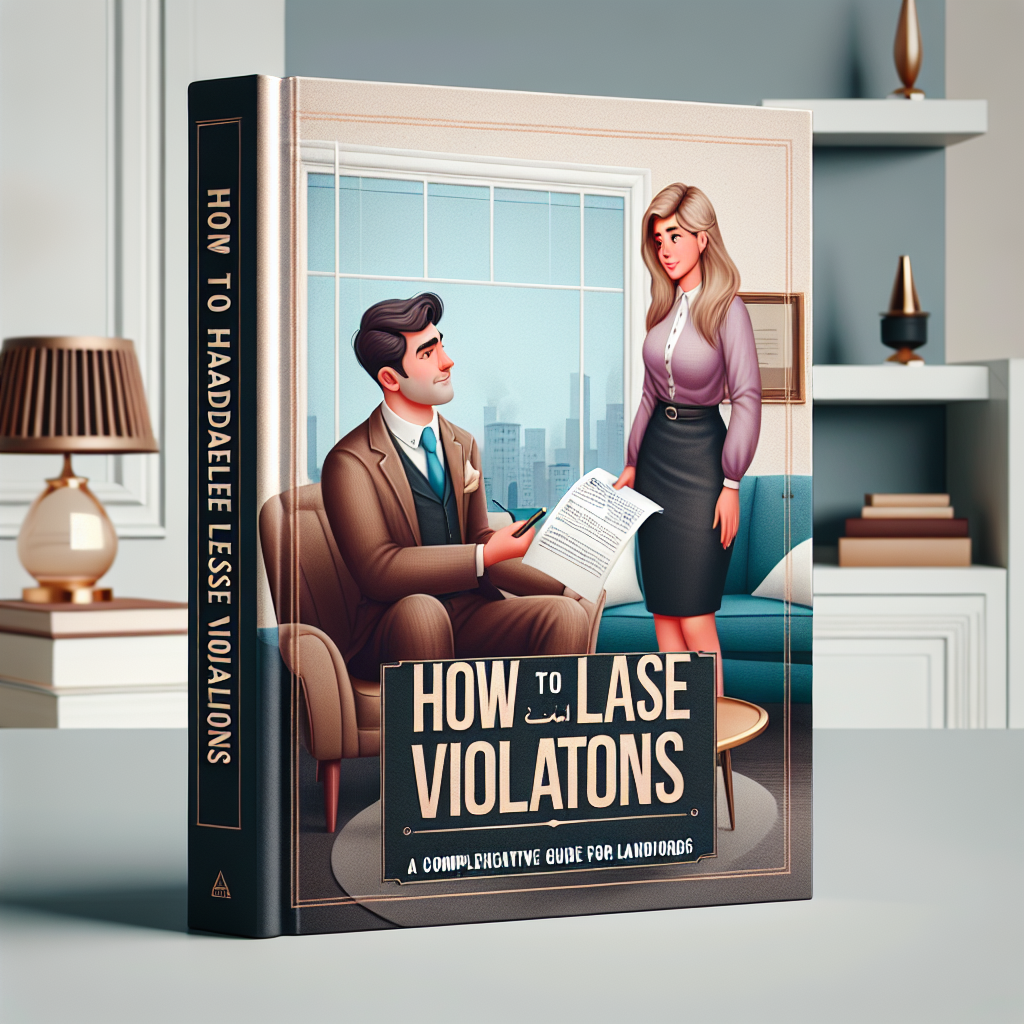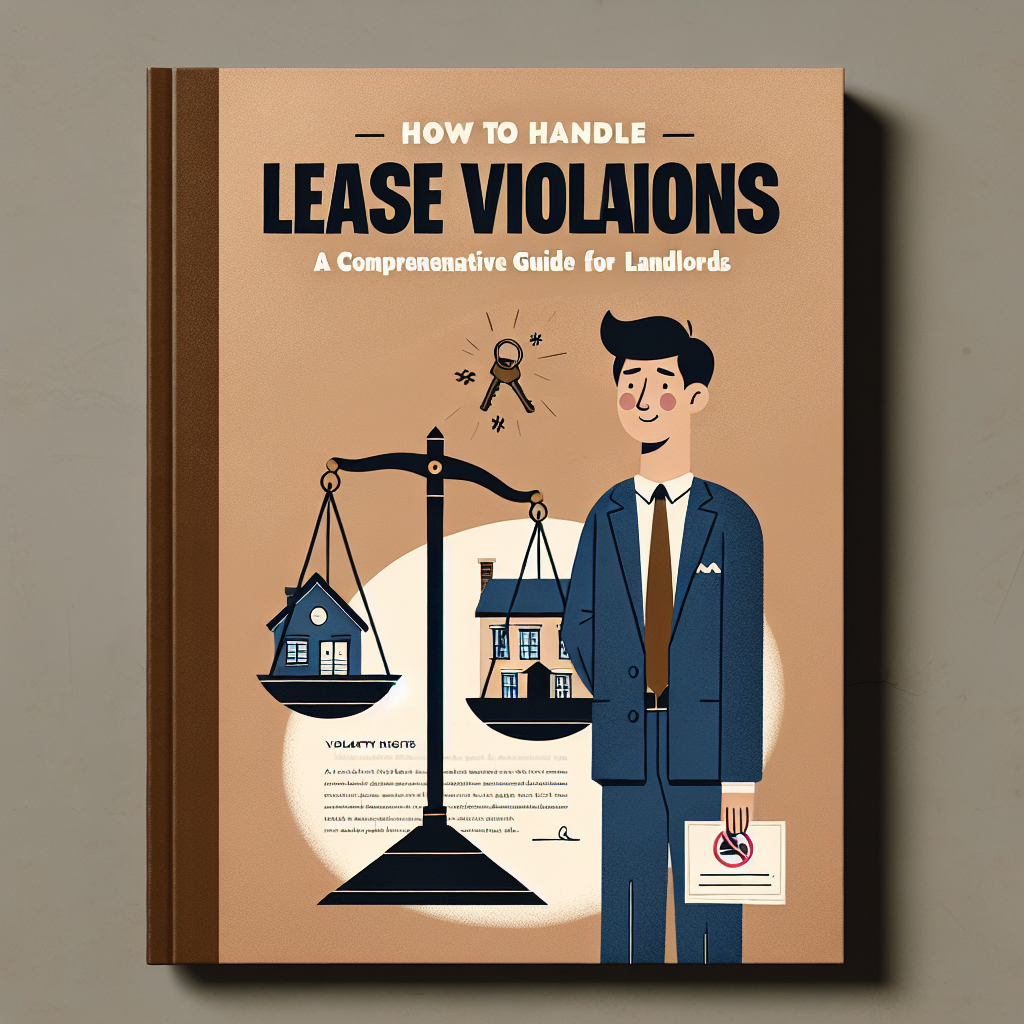-
Table of Contents
- How to Handle Lease Violations: A Comprehensive Guide for Landlords
- Understanding Lease Violations
- Common Types of Lease Violations
- Steps to Handle Lease Violations
- 1. Review the Lease Agreement
- 2. Document the Violation
- 3. Communicate with the Tenant
- 4. Issue a Written Notice
- 5. Follow Up and Monitor Compliance
- 6. Consider Mediation
- 7. Take Legal Action if Necessary
- Case Studies and Examples
- Case Study 1: Unauthorized Pets
- Case Study 2: Non-Payment of Rent
- Statistics on Lease Violations
- Preventing Lease Violations
- 1. Thorough Tenant Screening
- 2. Clear and Detailed Lease Agreements
- 3. Regular Property Inspections
- 4. Open Communication
- Conclusion
How to Handle Lease Violations: A Comprehensive Guide for Landlords

As a landlord, managing lease violations is an inevitable part of the job. Whether it’s late rent payments, unauthorized pets, or property damage, lease violations can disrupt the harmony of your rental property and affect your bottom line. This comprehensive guide will provide you with the tools and strategies needed to handle lease violations effectively, ensuring a smooth and professional resolution process.
Understanding Lease Violations
Before diving into the steps for handling lease violations, it’s crucial to understand what constitutes a lease violation. A lease violation occurs when a tenant fails to adhere to the terms and conditions outlined in the lease agreement. These violations can range from minor infractions to serious breaches that may warrant eviction.
Common Types of Lease Violations
- Non-payment or late payment of rent
- Unauthorized occupants or subletting
- Property damage beyond normal wear and tear
- Unauthorized pets
- Illegal activities on the premises
- Excessive noise or disturbances
Steps to Handle Lease Violations
Addressing lease violations promptly and professionally is essential to maintaining a positive landlord-tenant relationship and protecting your property. Here are the steps to handle lease violations effectively:
1. Review the Lease Agreement
Before taking any action, review the lease agreement to confirm that the tenant’s behavior constitutes a violation. Ensure that the lease terms are clear and specific regarding the issue at hand. This will provide a solid foundation for addressing the violation and enforcing the lease terms.
2. Document the Violation
Documentation is crucial when dealing with lease violations. Keep detailed records of the violation, including dates, times, and any evidence such as photographs, written complaints from other tenants, or communication with the tenant. This documentation will be valuable if the situation escalates and legal action becomes necessary.
3. Communicate with the Tenant
Open and clear communication is key to resolving lease violations. Contact the tenant to discuss the issue and provide them with an opportunity to explain their side of the story. Approach the conversation with a calm and professional demeanor, focusing on finding a resolution rather than placing blame.
4. Issue a Written Notice
If the tenant fails to address the violation after your initial conversation, issue a written notice outlining the specific violation and the steps required to remedy the situation. The notice should include:
- The nature of the violation
- The date the violation was observed
- The section of the lease agreement that has been violated
- The actions required to correct the violation
- A deadline for compliance
- Potential consequences if the violation is not resolved
Ensure that the notice is delivered in accordance with local laws and regulations, which may require personal delivery, certified mail, or posting on the property.
5. Follow Up and Monitor Compliance
After issuing the written notice, follow up with the tenant to ensure they are taking steps to address the violation. Monitor the situation closely and document any progress or lack thereof. If the tenant complies with the notice and resolves the issue, acknowledge their efforts and maintain open communication to prevent future violations.
6. Consider Mediation
If the tenant disputes the violation or fails to comply with the notice, consider mediation as an alternative to legal action. Mediation involves a neutral third party who can help facilitate a resolution between you and the tenant. This approach can save time, money, and stress compared to pursuing eviction or other legal remedies.
7. Take Legal Action if Necessary
If all attempts to resolve the violation fail, you may need to take legal action. This could involve filing for eviction or seeking damages for property damage or unpaid rent. Consult with an attorney who specializes in landlord-tenant law to ensure you follow the proper legal procedures and protect your rights as a landlord.
Case Studies and Examples
Case Study 1: Unauthorized Pets
In one case, a landlord discovered that a tenant had brought an unauthorized pet into the rental property, violating the lease agreement. The landlord documented the violation with photographs and issued a written notice to the tenant, outlining the steps required to remove the pet. The tenant initially resisted, but after a follow-up conversation and the threat of legal action, they complied and removed the pet. The landlord’s prompt and professional handling of the situation prevented further issues and maintained a positive relationship with the tenant.
Case Study 2: Non-Payment of Rent
Another landlord faced a situation where a tenant consistently paid rent late, despite multiple reminders and warnings. The landlord issued a written notice specifying the lease terms regarding timely rent payments and the consequences of continued late payments. When the tenant failed to comply, the landlord initiated eviction proceedings. The court ruled in favor of the landlord, and the tenant was evicted. The landlord’s thorough documentation and adherence to legal procedures ensured a successful resolution.
Statistics on Lease Violations
Understanding the prevalence and impact of lease violations can help landlords better prepare for and address these issues. Here are some relevant statistics:
- According to a survey by TransUnion, 84% of landlords have experienced late rent payments from tenants.
- A study by the National Multifamily Housing Council found that 35% of landlords have dealt with unauthorized occupants in their rental properties.
- The same study revealed that 22% of landlords have encountered property damage beyond normal wear and tear.
- Data from the American Pet Products Association indicates that 67% of U.S. households own a pet, highlighting the potential for unauthorized pets in rental properties.
Preventing Lease Violations
While it’s impossible to prevent all lease violations, there are steps landlords can take to minimize their occurrence:
1. Thorough Tenant Screening
Conducting thorough tenant screening is one of the most effective ways to prevent lease violations. This process should include:
- Credit checks
- Background checks
- Employment and income verification
- References from previous landlords
By selecting responsible and reliable tenants, you can reduce the likelihood of lease violations.
2. Clear and Detailed Lease Agreements
A well-drafted lease agreement is essential for preventing misunderstandings and disputes. Ensure that your lease agreement is clear, detailed, and covers all potential issues, including:
- Rent payment terms
- Occupancy limits
- Pet policies
- Maintenance responsibilities
- Noise and disturbance rules
- Consequences of lease violations
Review the lease agreement with tenants before they sign to ensure they understand their obligations.
3. Regular Property Inspections
Conducting regular property inspections can help you identify and address potential lease violations early. Schedule periodic inspections and provide tenants with advance notice. Use these inspections to check for unauthorized occupants, pets, or property damage, and address any issues promptly.
4. Open Communication
Maintaining open and transparent communication with your tenants can prevent many lease violations. Encourage tenants to report any issues or concerns and respond promptly to their inquiries. Building a positive landlord-tenant relationship can foster mutual respect and cooperation.
Conclusion
Handling lease violations is a critical aspect of property management that requires a proactive and professional approach. By understanding the types of lease violations, following a structured process for addressing them, and taking preventive measures, landlords can effectively manage their rental properties and maintain positive relationships with their tenants.
Key takeaways from this guide include:
- Reviewing the lease agreement to confirm violations
- Documenting violations thoroughly
- Communicating clearly and professionally with tenants
- Issuing written notices and following up on compliance
- Considering mediation before taking legal action
- Taking preventive measures such as thorough tenant screening and regular property inspections
By implementing these strategies, landlords can navigate lease violations with confidence and ensure the long-term success of their rental properties.








